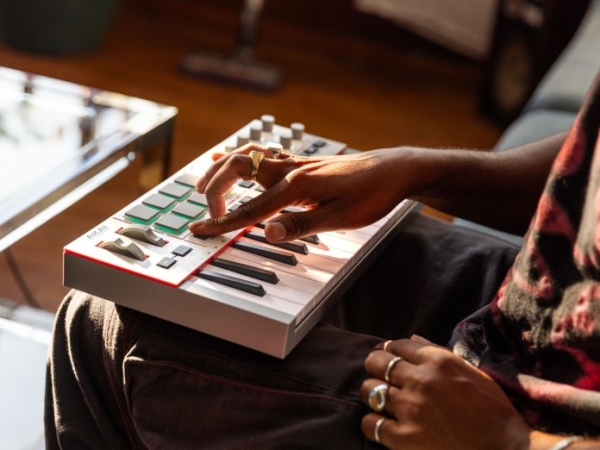At just $99, the Akai MPK Mini IV looks to “set a new standard” for portable music creation
Akai’s MPK Mini series has long been the go-to compact controller for producers who want real music-making power in a backpack-sized package. The newly announced MPK Mini IV keeps that spirit alive — but this time Akai has pushed the little controller into territory that used to belong to larger, more expensive gear. For $99, the MPK Mini IV bundles a redesigned keybed, proper pitch and mod wheels, a full-color screen, a big preset library, and modern connectivity — a combination that genuinely feels like a fresh attempt to “set a new standard” for what a portable MIDI keyboard should be able to do.
What’s different this generation
On the surface, the MPK Mini IV still looks like the compact, 25-note unit we know: small footprint, octave buttons, RGB MPC-style pads, and assignable encoders. But a handful of changes make it a noticeably more expressive and studio-ready tool:
-
Real pitch and modulation wheels. The old red joystick is gone — replaced with traditional wheels that players expect for expressive pitch bends and modulation. That’s a subtle change, but it matters when you’re trying to play leads or sculpt sounds live.
-
New keybed design. Akai says the MPK Mini IV uses an updated keybed for better feel and velocity response, which helps when you want more nuanced performances from only 25 keys. For laptop-and-backpack sessions, that improved tactile response matters more than it sounds.
-
Full-color display and workflow controls. The addition of a screen and expanded transport controls brings more on-device feedback and faster hands-on control of DAW functions, reducing the need to stare at your computer while you tweak.
-
USB-C + 5-pin MIDI out. Modern connectivity arrives with USB-C for bus power and bidirectional MIDI, while a dedicated 5-pin MIDI output keeps the Mini relevant for hardware-heavy setups and live rigs. That makes the unit as comfortable onstage as it is in a bedroom studio.
Those updates don’t all sound revolutionary individually, but together they change how you can use a pocket-sized controller — from sketching ideas in cafes to integrating with outboard synths on stage.
Value: hardware + software at an entry-level price
One of the most headline-grabbing elements is the price: $99 USD. For that figure, Akai isn’t just offering a small keyboard — it ships with access to a bundled “Studio Instrument Collection” of more than 1,000 presets and sounds from AIR, Moog, and Akai, designed to get you making full productions straight away. For new producers or anyone who wants immediate, high-quality tones without hunting for separate plugins, this bundle significantly boosts the out-of-the-box value.
When you compare this to purchasing a small hardware controller plus even a single high-quality VST, the MPK Mini IV’s price becomes more persuasive: hardware + software that’s useful in real production workflows at a mass-market price point. Music tech outlets have framed it as Akai trying to reassert the MPK Mini as the affordable standard-bearer for portable creation — and the specs back that up.
Who this is for (and who might benefit most)
The MPK Mini line historically lives in two worlds: beginners who need a small, affordable entry into MIDI controllers, and experienced producers who want a compact unit to travel with. The IV seems deliberately aimed at both groups:
-
Beginners: The included sound library and one-to-one parameter mapping make it easier to start producing without juggling multiple purchases. The hardware is approachable and straightforward, and the screen helps demystify parameter changes.
-
Traveling producers / live performers: Real wheels, 5-pin MIDI, and USB-C power make the controller viable as part of a live rig or hardware-centric studio. The lighter footprint and robust mapping allow you to control both software and external synths.
-
Beatmakers and finger-drummers: The MPK’s RGB MPC pads remain central to the device’s appeal. Pressure-sensitive, RGB-backlit pads with assignable encoders are ideal for both drum programming and expressive pad performance.
If you’re someone who already owns a large controller or prefers full-sized keys and aftertouch, this isn’t a replacement — it’s a complement. But if you’ve been waiting for a truly portable controller that doesn’t force trade-offs in playability or connectivity, the IV makes a compelling case.
Practical workflow improvements
A few real-world workflow touches are worth highlighting because they change how fast you can move from idea to finished loop:
-
DAW mapping and transport controls: The expanded transport controls and DAW-friendly shortcuts are mapped to major DAWs out of the box, so basic recording and editing tasks are literally at your fingertips. That reduces awkward menu diving when you’re in the zone.
-
Screen feedback: Seeing parameter values on a small screen cuts down guesswork — useful when editing synth parameters or switching presets on stage.
-
Preset integration with the hardware: Akai’s promise of tight software/hardware integration (1-to-1 parameter mapping) means that the knobs and encoders won’t require endless MIDI learn steps for common instruments included in the bundle. That smoothness matters for fast creative sessions.
These details make the MPK Mini IV feel less like a cheap, stripped-down controller and more like a thoughtfully designed mini-instrument.
Limitations and realistic expectations
No magic: there are natural limits to what a 25-key controller can replace. If your workflow relies on full-sized, weighted keys, poly-aftertouch, or an abundance of knobs and faders, you’ll still want larger hardware. Some other limitations to keep in mind:
-
Key size and range. With only 25 keys and octave switches, complex piano parts still require either careful programming or a second, larger keyboard for serious performance.
-
Aftertouch / deeper expression. If you require polyphonic aftertouch or advanced expressive tech built into the keybed, that’s usually reserved for higher-tier controllers. The IV’s upgrades improve feel, but they don’t turn it into a high-end stage keyboard.
-
Build expectations. At $99, the MPK Mini IV is impressively specified, but it’s still a compact plastic device. For the majority of producers, that’s fine; for frequent onstage abuse, you’ll want a protective case and careful handling.
The competition and where the MPK Mini IV fits
The compact controller segment is competitive: Arturia’s MiniLab series, Novation’s Launchkey Mini line, and Akai’s own prior generations have occupied similar price brackets. What the MPK Mini IV tries to do differently is combine pro-grade expressive elements (wheels, better keybed), modern connectivity (USB-C + 5-pin MIDI), and a generous software package — all at an entry-level price. That cocktail of features positions it as an attractive first-choice for folks who want a one-box start-to-finish creative tool.
Final thoughts: Does it “set a new standard”?
Calling any single product “the new standard” is bold — and the claim relies on how you weigh portability, playability, and price. But Akai’s MPK Mini IV does something important: it narrows the compromise between compactness and functionality. By bringing expressiveness (real wheels), better playability (new keybed), modern I/O (USB-C and 5-pin MIDI), and an extensive sound library together at $99, Akai has raised expectations about what a sub-$100 compact controller can deliver. For many creators — students, traveling producers, bedroom beatmakers — that’s a meaningful shift.
If you’re shopping for a small controller right now, the MPK Mini IV deserves a serious look. It isn’t a replacement for pro-stage keyboards or full-sized controllers, but as a portable creative companion that helps you make music faster and with fewer compromises, it arguably does set a new bar for value and usefulness in this category.
Sources & further reading: Akai’s official MPK Mini IV page (product details and Studio Instrument Collection), MusicTech’s article announcing the MPK Mini IV, MusicRadar’s feature, retailer/spec pages (Sweetwater), and industry press coverage used to summarize specs and feature context.


